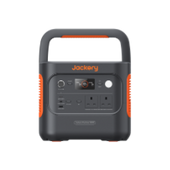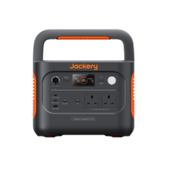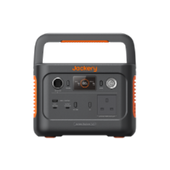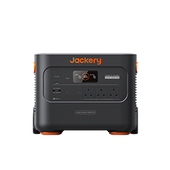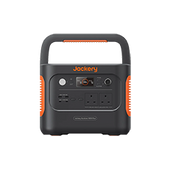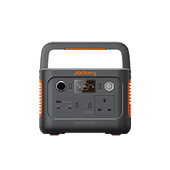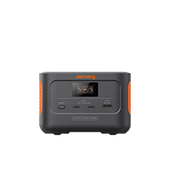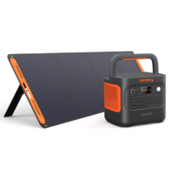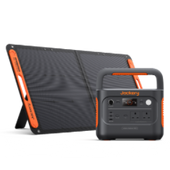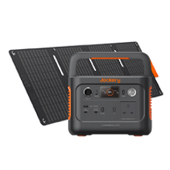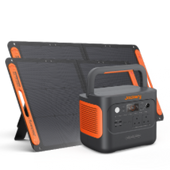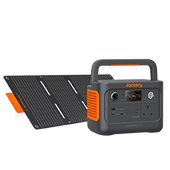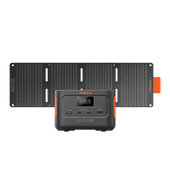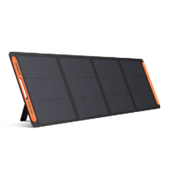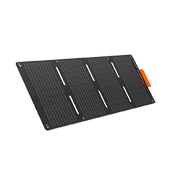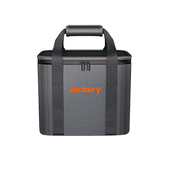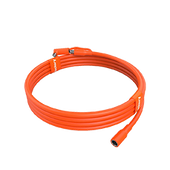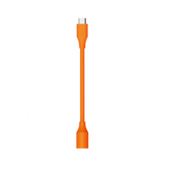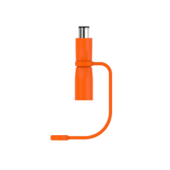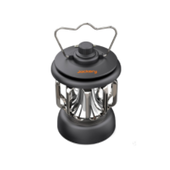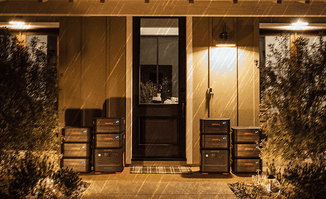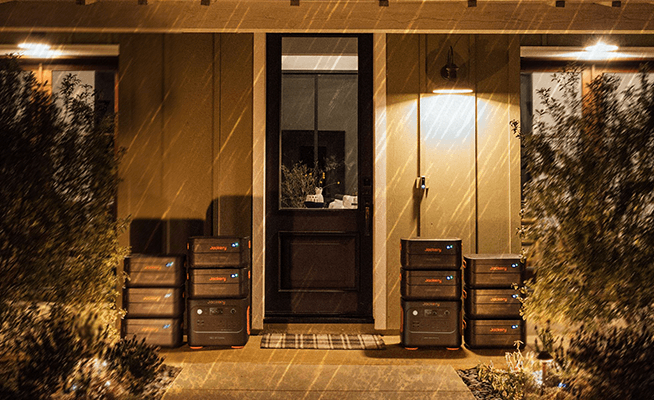Spring wreaths are made of leaves, flowers, and decorative elements woven into a circle and can be used to celebrate various occasions, such as weddings, birthdays, holidays, and seasonal events. Not only do they look beautiful, but they also symbolize unity, eternity, and the cycle of life. Classic flower wreaths, herb wreaths, and environmentally friendly material wreaths have all become popular spring wreath styles in recent years.
This guide mainly describes the six steps of making a spring wreath base, preparing flowers, assembling the wreath, and adding decorations. It also includes a list of tools and materials for making spring wreaths. Jackery Portable Power Station could be a great helper for powering your DIY tools outdoors.
|
Key Takeaways: |
|
- In recent years, classic flower wreaths, Herb Wreaths, and environmentally friendly material wreaths have all become popular spring wreath styles. - To make a spring wreath, you need materials such as flowers and decorations and tools such as hot-melt glue guns and portable power stations. - The steps to make a spring wreath include making the wreath base, preparing flowers, assembling the wreath and adding decorations. - Wrap thick hemp or cotton rope around the door handle to secure the spring wreath and tie a double knot. - If you have plenty of time and pursue uniqueness, you can make a spring wreath yourself. - We highly recommend Jackery Explorer 100 Plus and 240 v2 portable power stations to power your DIY tools outdoors. |
What Are the Popular Types of Spring Wreaths?
Spring wreaths are an easy way to give your front door or mantel a new look and add charm. In the UK, popular spring wreath styles often combine seasonal flowers, natural elements and festive atmosphere, reflecting traditional aesthetics while incorporating modern design. The following are the popular styles of spring wreaths that have been common in recent years:
Classic Flower Wreath
Classic spring wreaths are usually based on spring flowers such as Daffodils, Tulips, Hyacinths, Daisies, etc., with Forget-me-not or Lily of the Valley. They are typically woven with rattan or willow branches on a round or heart-shaped base, decorated with ferns, etc.
Succulent and Green Plant Wreath
Succulent and green plant wreaths are usually made of drought-resistant succulents (such as sedum) or mosses and are paired with air plants, which are more suitable for indoor hanging. Wreaths made of succulents and cold-resistant green plants are durable and ideal for people who dislike changing flowers frequently.
Herb Wreath
The practical and beautiful Herb Wreath is usually made of herbs such as Rosemary, Lavender, Thyme, etc., which exudes a fresh fragrance. Some even decorate the wreath with native aromatic plants such as mint and lemon balm. Herb Wreath, which is often fixed with hemp rope or coarse cloth, is more suitable for hanging in the kitchen or courtyard.
Bird and Bird Nest Theme Wreath
The wreath woven with branches into the shape of a bird's nest and decorated with simulated bird eggs, feathers or robins symbolizes the vitality of spring. For example, you can weave willow branches into the shape of a bird's nest and decorate it with foxgloves, hawthorn flowers, handmade feathers or resin birds.
Environmentally Friendly Material Wreath
The British, who value environmental protection, often make a sustainable wreath with recycled paper, dried flowers, dead branches, or degradable materials. For example, you can try weaving a wreath with dried hydrangeas, pine cones, and branches and matching it with a linen bow.
List of Materials and Tools for Making a Spring Wreath
Clear a large workspace before making a spring wreath and prepare the necessary tools and materials.

Tool List for Spring Wreath
The right and good quality tools can help you make spring wreaths easier. Here is a detailed tool list:
Pruning Shears: Pruning shears can be used to prune thicker flower branches, such as ivy, cherry, and daffodil stems.
Scissors: Scissors can be used to trim thinner flower branches and ribbons.
Wire Cutters: Wire cutters can be used to cut wire.
Hot Melt Glue Gun: You can use a hot melt glue gun to fix flowers, vines, or other decorations.
Tweezers: Tweezers can help you adjust the small decorations of the spring wreath.
Gardening Tape: Gardening tape can be used to wrap wire to prevent scratches and to fix plant branches.
Spray Bottle: You can use a spray bottle to spray water to keep the flowers moist while making spring wreaths.
Portable Power Station: The Jackery Explorer series portable power station can power your hot melt glue gun.
Materials List for Spring Wreath
The specific materials needed to make a spring wreath in the UK vary, depending on the wreath style, the effect you want to present, and the differences in seasons. However, any spring wreath consists of three core components: the base, branches and leaves, and decorations. Here is a detailed materials list:
Wire/Metal Wreath Frame: You can prepare a metal base frame with a diameter of 20-30cm or prepare some wire to make a frame.
Spring Flowers (local varieties are optional): You can usually choose flowers to decorate spring wreaths according to your preferences, such as daisies, tulips, daffodils, lily of the valley, carnations, and roses.
Fake Flowers: If obtaining fresh flowers is difficult, use sustainable counterfeit flowers instead.
Branches and Leaves: You can choose green branches and leaves such as willow branches, olive branches, eucalyptus leaves and ivy.
Moss and Fern Leaves: If you can, collect some moss and fern leaves to decorate the base of the spring wreath.
Decorations: Beads, pine cones, dried lemon slices, eggs, feathers, butterfly models, bird nests and other decorations can be attached with hot melt glue.
Hemp Rope, Lace, or Printed Ribbon: To make an exquisite spring wreath, wrap the wire or decorate the edges with ribbon. Spring wreaths can usually be decorated with four generations of spring colours, such as light pink, goose yellow, mint green, etc.
How to Make a Spring Wreath: Step-by-Step Guide
Now that you have all the materials and tools to make a spring wreath, it's time to start. Follow this step-by-step guide to make a basic spring wreath (using a flower wreath as an example):

Step 1: Make a Wreath Base
Flower wreaths often come with a moss base, which is made of a wire frame and covered with natural moss. You must wrap the wicker ring with thin wire 2-3 times to secure the joints or use hot melt glue to seal and reinforce it. Then, spiral ivy branches around the base to cover the frame and create a natural texture.
Next, you must continue adding moss to the reinforced frame until the entire frame is covered with moss. As you add moss, you can wrap it with a metal wire spool to form the structure of the wreath.
Step 2: Prepare the Flowers
Once you have collected all the leaves and flowers you need, it's time to prune and tidy. You need to use pruning shears or scissors to trim the leaves to the correct size to fit neatly on the wreath frame. For example, keep 5-8cm of flower stems when pruning flowers. After trimming, wrap the wire with floral tape to secure the flower stems to prevent dehydration. Keep 2-3 larger flowers as the focal point of the spring wreath.
Step 3: Assemble the Wreath
You can now use the uncut wire spools to secure the bunches of green leaves you need to add to the moss base. Overlap each bunch to cover the stem of the previous bunch.
After adding the bunches of green leaves to the moss base, you can arrange the processed flowers upwards. Starting from the bottom of the spring wreath, insert the central flower into the base at a 45° angle and fix it with hot melt glue. For example, the lower layer of the spring wreath can be inserted with larger flowers such as ranunculus or azalea. The middle layer of the spring wreath can be inserted with small flowers such as daisies. The outer layer of the spring wreath can be inserted or wrapped with lavender branches to add fragrance and bright lines.
After arranging the spring wreath flowers, you can insert fern leaves between the flowers to simulate natural growth.
Step 4: Add Decorations
Consider adding some favourite decorations to make a delicate spring wreath. For example, you can wrap a cream lace ribbon around the base or make a bow with ribbon to fix it on the top or side. Alternatively, you can use a hot glue gun to glue spring decorations such as eggs and feathers to the spring wreath to create an Easter atmosphere. Some people also string pearls between flowers to create a classic and elegant atmosphere.
Step 5: Make a Hanging Ring
Spring wreaths usually hang on doors and windows, so make a ring for hanging. Leave about 30 cm of uncut wire to make a hanging ring from the base. If the wire is too long, don't cut it; you can wrap it around the bottom of the ring you made to fix it.
Step 6: Final Adjustments
After completing the spring wreath, ensure all the fixing points are secure. For example, you must confirm that all hot melt glue points have cooled and that the wire has no exposed sharp parts. Then, check the wreath for balance and symmetry and adjust any elements that might stick out or look uneven, such as trimming away any excess foliage or wire that sticks out. It's best to gently rotate the spring wreath to balance all angles visually and avoid dense clumping.
How to Hang a Spring Wreath?
In the UK, hanging spring wreaths is a typical decoration, especially during Easter or spring celebrations. When hanging spring wreaths, you need to consider both beauty and stability, as well as the material and climate of the door. Here are the specific steps and precautions:

Choose a Hanging Location
In the UK, most people hang spring wreaths in the centre of the door to avoid blocking the doorplate or cat's eye. Hanging spring wreaths with ribbons on windows or walls is also a good choice. A few people hang spring wreaths on fireplaces or stair railings to create a spring atmosphere.
Prepare Hanging Tools
If you want to fix spring wreaths firmly, prepare some tools beforehand.
Non-marking Hooks: Use non-marking hooks to avoid damaging the surface of doors and windows.
Door Hanging Hooks: This hook is designed for the top of the door and can be hung on the upper edge of the door.
Small Nails or Screws: If you need to fix spring wreaths on the wall or wooden door, you may need to use nails or screws.
Ribbon/Hemp Rope: If the spring wreath has a hanging loop, you can hang it with a decorative ribbon or hemp rope.
Different Hanging Methods
Here are different ways you can try to hang the spring wreath:
S-hook Fixing Method: For modern doors without door hooks, install an S hook on each side of the door frame and pass the spring wreath rope through the hook loop to form a stable support.
Knot Hanging Method: Wrap thick hemp or cotton rope around the door handle to fix the spring wreath and tie a double knot. However, this method is only suitable for temporary hanging or lightweight spring wreaths. You also need to check the tightness of the knot regularly to prevent it from falling off due to frequent door opening and closing.
Traceless Hook Fixing Method: Stick traceless nails or strong command hooks on the door's surface and then hang the spring wreath. This is suitable for renting houses or scenes where you don't want to drill holes but must test the load-bearing capacity.
Make or Buy a Spring Wreath: Which Is Better?
Many people will be entangled when using spring wreaths to create this spring ritual: should they make it themselves or buy a refined finished product directly? DIY a spring wreath or buy a finished product depending on your needs, budget, time and creative preferences. The following will analyze from multiple aspects to help you make a more suitable choice for you:
Personalized Expression
The most considerable charm of a homemade spring wreath is its "unreplicability." In short, you can choose flowers, colours, and styles according to your preferences to create a unique decoration.
Although the spring wreath purchased from the store can meet the public aesthetics through serialized design, it lacks uniqueness and is challenging to match personal aesthetics fully.
Cost
The price range of commercially available spring wreaths ranges from cheap dried flower basics to costly handmade custom models.
The cost of a homemade spring wreath is controllable. If you already have basic materials (such as rattan rings, ribbons, glue guns, etc.), using natural flowers or idle items (dried flowers, fabrics, paper art) may be more cost-effective.
Time Investment
Homemade spring wreaths are time-consuming and labour-intensive. The production process includes purchasing materials, trimming flowers, and fixing shapes. It may take several hours or even longer, so it is suitable for people who have plenty of time. Generally, it takes 2.5 hours to complete a spring wreath of standard size (40cm in diameter).
Buying spring wreaths directly does not require waiting, which saves time and worry. It is suitable for busy people or those not interested in handicrafts.
Design and Skills
Commercially available spring wreaths are usually exquisitely crafted and coordinated, with fresh-keeping treatment of fresh flowers and realistic flower simulation. In addition, they have professional designs and stable production characteristics.
Most novices find it difficult to grasp the production skills of homemade spring wreaths. If you pursue exquisite effects, you must learn basic techniques such as fixing flowers and colour matching. Homemade spring wreaths may have unused flowers or may not be prepared enough.
|
|
Advantages |
Disadvantages |
|
DIY a Spring Wreath |
Highly personalized Cost-controlled Experience fun |
Time-consuming and labour-intensive Requires high skill Excess or insufficient materials |
|
Buy a Spring Wreath |
Time-saving and worry-free Professional design Instant results |
Higher price Lack of uniqueness Material restrictions |
In short, please choose to make your spring wreath or buy the finished product directly according to different situations and personal needs. If you have plenty of time, like handicrafts, pursue uniqueness, or want to give the wreath special meaning, consider making a spring wreath yourself. However, if you have a sufficient budget, seek efficiency, or are unsure about the effect of making your own, please consider buying a ready-made spring wreath directly.

Jackery Portable Power Stations for DIY
Ah, a spring wreath! What a lovely idea. While a Jackery Portable Power Station itself isn't a direct tool for making a wreath (you'll still need your flowers, greenery, and crafting supplies!), it can certainly be a fantastic enabler, especially if you plan to craft your wreath outdoors or in a location without easy access to power.
Many modern crafting tools are cordless and require charging. Think glue guns, small sewing machines for embellishments, or even string trimmers if you're harvesting your natural materials. A Jackery can keep these tools powered up and ready to go, no matter where your creative inspiration strikes.
As the days get longer in spring, you might still find yourself crafting in the late afternoon or early evening. A Jackery can power a portable work light, allowing you to see clearly and continue your project comfortably, even as natural light fades.
While you're focused on your beautiful creation, you might enjoy having some background music or a podcast playing. Jackery Explorer 100 Plus or 240 v2 can power a portable speaker or even charge your phone so you can stream your favourite tunes or crafting tutorials.
Jackery Explorer 100 Plus
The Jackery Explorer 100 Plus has a LiFePO4 battery that endures 2,000 cycles while maintaining 80% of its capacity. Weighing only 965 grammes, it offers portable power conveniently within your grasp. Furthermore, it is sufficiently lightweight and small for transport, perfect for DIYing or outings.

- Ideal Companion for Making Crafts: The Explorer 100 Plus is a portable power station with a 128W AC Pure Sine Wave Inverter and a capacity 99Wh. It can charge three devices concurrently, featuring a 100W Dual PD Output and one USB-A output. While small and ultra-portable, the Jackery Explorer 100 Plus can still be a helpful companion for making spring wreaths, primarily for keeping your essential devices running.
- Compact Size & Light Weight: Its key advantage is its compact size and lightweight, making it incredibly easy to carry in a backpack without adding significant bulk. While it cannot power larger appliances or multiple devices simultaneously for extended periods, the Explorer 100 Plus is a reliable personal power bank. It gives you independence from crowded charging stations and powers your crafting tools and lights.
- Various Recharging Methods: MPPT technology guarantees 99% efficiency in solar charging. A complete DC input requires 1.8 hours, whereas solar charging with a single SolarSaga 100W solar panel necessitates 2 hours. Jackery provides comprehensive solutions for all scenarios, including car charging and alternative charging methods.
|
DIY Electric Tools & Devices |
Running Time |
|
Electric Glue Gun (60W) |
1.3H |
|
Small Sewing Machine (50W) |
1.6H |
|
Phone (29W) |
6.2 Times |
|
Portable Speaker (30W) |
2.6H |
|
Light (5W) |
16H |
(*The working hours are only for reference; the actual working hours depend on your usage.)
Jackery Explorer 240 v2
Its key advantage for making spring wreaths is its portability: it's lightweight and easy to carry in a backpack. While it won't run larger appliances for long, the Explorer 240 v2 provides a reliable personal power source, offering independence from your home utility. It allows you to enjoy the DIY process without worrying about your vital devices running out of battery.

- Smaller Power Solution: The Explorer 240 v2 Portable Power Station is small but has a strong 256Wh capacity. At about 7.94 lbs and with a tiny foldable handle, it is more lightweight and portable than conventional models, allowing for effortless storage in your bag. It has one wall outlet, USB-A port, and USB-C port to charge up to five devices simultaneously.
- Recharging Made Easy: Quickly charge your gadgets and enjoy a longer battery life. Stay charged and linked no matter where you go. You can recharge it with SolarSaga 80W for 5 hours, a wall outlet for 2 hours, and even carport recharging for 5 hours.
- Emergency Charging within One Hour: The Explorer 240 v2 Portable Power Station can be fully charged from 0% to 100% in one hour through an app. It is possible with the Emergency Charging Mode. Your portable power pack will ensure you never run out of power while making crafts outdoors.
|
DIY Electric Tools & Devices |
Running Time |
|
Electric Glue Gun (60W) |
3H |
|
Small Sewing Machine (50W) |
3.5H |
|
Phone (29W) |
11 Times |
|
Portable Speaker (30W) |
5.2H |
|
Light (5W) |
40.6H |
(*The working hours are only for reference; the actual working hours depend on your usage.)
Spring Wreath FAQs
The following are the frequently asked questions about the spring wreath:
1. How many flowers do you need to make a spring wreath?
The number of flowers you need to make a spring wreath is usually affected by factors such as the size of the wreath, the size of the flowers, the density of the design, and the balance of flower types.
Example: If you want to make a 12-14 inch spring wreath, the number of flowers you need is as follows:
Large focal flowers (such as tulips): 30-36 stems,
Medium focal flowers (such as roses): 8-10 stems
Small filler flowers: 6-8 bunches
2. What is the best base for making a spring wreath?
When choosing a base for a spring wreath, most people consider foam wreath bases or wireframes with moss bases.
Choosing a
foam wreath base will be easier because you can insert or glue the leaves and flowers. The wireframe with a moss base looks more beautiful.
In short, various wreath bases have advantages and disadvantages, and what to choose is entirely based on personal preference.
3. How long can a spring wreath last?
The time that spring wreaths made of different materials can last varies. For example, a spring wreath made from fresh flowers can last 1-2 weeks if properly moisturized. A spring wreath made from artificial flowers can last years if kept dry and out of direct sunlight.
4. How do I maintain my spring wreath?
Proper care and storage will help the spring wreath last longer. Here are some tips for maintaining your spring wreath:
Regularly wipe away any accumulated dirt or debris on the spring wreath.
Do not place the spring wreath in areas with high humidity, extremely high temperatures, or in direct sunlight.
For a spring wreath made from fresh flowers, spray it with water every few days to keep it moist and fresh.
Store a spring wreath made from artificial flowers in a storage box or plastic bag in a cool, dry place.
Final Thoughts
In short, a spring wreath is a decoration in the UK and a symbol of a ritual to welcome sunshine and nature. If you have plenty of time, like handicrafts, pursue uniqueness, or want to give a wreath a special meaning, consider making a spring wreath yourself. Depending on your preferences and occasions, you can use fresh, dried, or artificial flowers to create a spring wreath. After making it, if the spring wreath comes with a hanging ring, you can hang it with a decorative ribbon or hemp rope.

